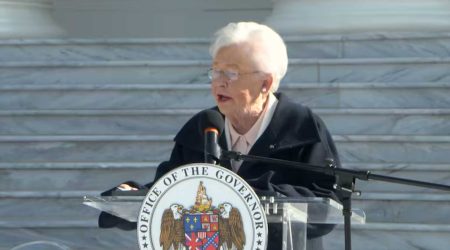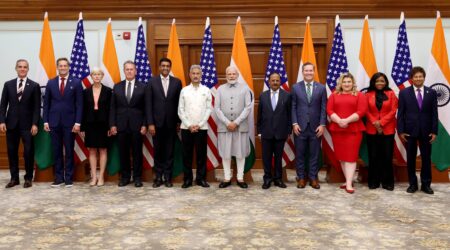By Prakash Bhandari
Gaj Singh, the last ruler of Jodhpur was only four years old in 1952 when he was crowned the 38th Rathor chief of Marwar following the death of his father Maharaja Hanwant Singh, who died in an air crash along with Zubeida, a film actress whom he had married. When his coronation took place, the little prince had no clue why the people of Jodhpur were celebrating on the streets hailing the new king.
He was given official recognition as the new Maharaja of Jodhpur seventy years ago when President Dr. Rajendra Prasad signed the Presidential Warrant of Recognition.
As the Oxford-educated Maharaja, celebrated his 75th birthday on January 13 this year, he became the only living former ruler, who had received Presidential recognition, and later as fate would have it, he became a titular Maharaja, following the abolition of privileges of princes.
After the abolition of privileges, he preferred being called as Gaj Singh of Jodhpur. It was a decision that he had to take following the decision of late Prime Minister Indira Gandhi to strip the princes of their titles and their privy purses.
Prior to him his grandfather Maharaja Ummed Singh and then his father Hanwant Singh ruled the Marwar region with full authority as monarchs.

Gaj Singhji with Umaid Bhavan in the background
He was born in the majestic Ummed Bhawan — now a palatial hotel — only 77 days before the Marwar principality’s accession to the new republic of India. Later, after the merger of various princely states, the Rajasthan state was formed.
Gaj Singh’s father Hanwant Singh was 29 years old when he died in the air crash. He had contested the Jodhpur Lok Sabha election in 1952 and won the seat, but he died before he could receive the certificate of his victory in the election. He had won the first Lok Sabha election from Jodhpur trouncing the Congress. Hanwant Singh fought against the Congress and his candidates won four other Lok Sabha seats and 31 of the 34 Vidhan Sabha seats.
But Gaj Singh as a toddler had no knowledge of what was happening. He was ascended to the Marwar gaddi (throne) on May 12, 1952. But though a Maharaja, he could not rule his state as all the princes lost their kingdoms and the power to rule under a new democratic India.
Gaj Singh was addressed as Bapji by all. His mother took the decision to send her only son to study in England’s Cothill House and then Eton College.

The Royal Family of Jodhpur: Maharaja Gaj Singhji (center), flanked by Rajmata Saheb (left) and Maharani Saheb Hemlata Rajye (right). Standing, on left, Baijilal Shivranjani Raje and on right, Yuvraj Saheb Shivraj Singh
“She didn’t want me to grow up in a palace, with palace retainers, thinking nothing had changed,” Gaj Singh told an American journalist.
In England, he studied in schools and then went to Oxford to earn a degree in philosophy, politics and economics. While studying in England, he would come on holidays to Jodhpur to be with his mother and sister.
Being a minor, the former ruling state was managed by an administrator in consultation with his mother Krishna Kumari. The estate of Jodhpur was managed by Jaikrit Singh as the administrator.
Gaj Singh was 23 when he returned to Jodhpur in 1971, armed with his Oxford degree. India was changing then.
Prime Minister Indira Gandhi was determined to strip the royal families of their titles and eliminate the “privy purses” or allowances that had been offered to them as recompense for disbanding their princely states after independence.

The majestic Mehrangarh Fort with royal cenotaph Jaswant Thada in the foreground.
It was a situation for which the former rulers, Gaj Singh included were not prepared. They unsuccessfully tried to fight their case.
Gaj Singh was served a body blow by this decision. He would become a titular Maharaja from being a recognized Maharaja.
As defined in 1949 under Article 291 of the Indian Constitution, a privy purse would be a fixed, tax-free sum guaranteed to the former princely rulers and their successors. The sum was intended to cover all expenses of the former ruling families, including those incurred for religious and other ceremonies, and would be charged on the Consolidated Fund of India.
With India remaining a member of the sterling area post-independence, and with the Indian rupee remaining pegged to the British pound sterling, the privy-purse payments constituted a significant outlay of government funds.
Jodhpur was receiving a privy purse of Rs 10 lakh a year which barely covered the expenses the former ruling state was incurring in maintaining the palace and fort.
Stripped of his annum allowance, Gaj Singh needed to find a way to offset the maintenance cost of the palaces, forts, jewels, paintings, and cars—including a Rolls-Royce Phantom II—that made up his lavish inheritance.
Young, decisive, and armed with a handful of advisers, he formed trusts and companies to protect and reinvest his assets. While in Europe he’d seen how the nobility had turned stately homes into hotels and thrown open their magnificent gardens for ticketed tours.
The rulers of Udaipur and Jaipur had converted their palaces into hotels. But Gaj Singh took time to convert his old majestic properties into hotels. He turned his 347 rooms majestic Ummed Bhawan Palace into a hotel and later some more properties were converted into hotels.
Gaj Singh started giving attention to the Mehrangarh Fort, which looms 400 feet above Jodhpur. For decades, bats were the fort’s only permanent residents and in the early 1970s Gaj Singh’s first income from Mehrangarh was from the sale of their droppings. His Mehrangarh Fort Trust sold the bat guano to chili farmers as fertilizer.

The exquisite interiors of Mehrangarh Fort
Gaj Singh donated nearly 15,000 items from his personal collection to the trust to create a museum within the fort. Opened in 1974, it’s a dazzling selection with broad appeal.
Today the fort attracts more than one million paying visitors a year. Admission fees support a staff of nearly 300, including security guards and craftspersons, and Mehrangarh is self-sustaining.
Gaj Singh turned a 172-acre rocky wilderness below the fort into a park. He could have sold the land and earned money, but he developed it as a desert park with 300 species of plants.
Jodhpur became a tourist destination and with air connectivity, more and more domestic and foreigners started visiting the fort and palaces.
He held several exhibitions abroad to sell the rich treasures of the Marwar rulers.
The exhibition made its award-winning debut at the Smithsonian before traveling to three continents. The Guardian newspaper, writing about its appearance at the British Museum in London, hailed it as “the most intoxicating show of the year.” The exhibition was a milestone for Gaj Singh, helping establish his credentials globally as a serious conservator.
Gaj Singh never lived in Mehrangarh but converting Jodhpur’s 347-room Umaid Bhawan Palace into a hotel meant opening the doors of the home where he has lived most of his life. Umaid Bhawan Palace management was taken over by the Taj Group and the luxury hotel chain Taj stepped in, putting the palace on the map as one of the world’s great destinations.
Umaid Bhawan was built as an act of charity—to give jobs to the poor to stave off famine during a drought. The 3,000 half-starved people who toiled to build the palace for well over a decade may not have seen it that way, of course.
Originally, the palace zenana was the exclusive purview of women. It was where they lived. But the zenana wing is now the primary residence of the Gaj Singh family. It has its own garden, as big as a public park, with wild parrots and strutting peacocks. Lalique glassware and antique furniture adorn the high-ceilinged rooms. Gaj Singh’s office adds some homey touches. It is full of handsome art but the largest painting is a portrait of his two children when they were young. His dogs have been named after alcoholic beverages.
Gaj Singh has served as India’s High Commissioner to Trinidad and Tobago and was also a member of the Rajya Sabha. His son, Shivraj Singh, and daughter Shivranjini Raje helped him in running the business.
Gaj Singh has witnessed many ups and downs but he worked hard to restore the old monuments and was responsible for the restoration of the Nagaur Fort.
Gaj Singh has revived polo and he runs a school also. He is loved by the people of Jodhpur and he attends various social functions where people love to invite him as a person who loves the people of Jodhpur.
Gaj Singh has lived life king-size, both as Maharaja and now as a titular Maharaja. How people loved him was seen when he cut a 70 kg cake with a sword. It was not a cake but a saffron Peda a local delicacy that was sent to him by the people, who still love and adore him.











